My German dormmate gave me calcium tablets when I got a cramp in my calf, a South African expertly treated my blisters when I was confronted with them, and a Canadian and Australian became my walking companions for over a week. That’s how easy it is to make friends on the Camino de Santiago – four strangers unexpectedly became my support system. In this blog I share why albergue life has such magical qualities and how you too can experience those special pilgrim bonds.
Many people are put off by the idea of sharing a dormitory with strangers. But it’s precisely in these albergues that a special transformation takes place. The transformation from fear to connection. The psychology of albergue life ensures that shared vulnerability and simplicity form the perfect breeding ground for authentic friendships.

1. The Magic of Albergue Life – Why Do Friendships Form So Easily?
In the albergue, everyone is literally lying next to each other in their underwear. As a result, all social masks quickly fall away. You see each other at your most pure moments: tired, sweaty, sometimes emotional. This immediately creates a feeling of equality.
Everyone is in the same boat: or rather, the same dormitory. We all have the same “enemies” like covering long distances, weather conditions, or a (too) heavy backpack. This “we” feeling strengthens that bond.
Sometimes you solve problems together that you encounter. Think of questions like: Where is the pharmacia (pharmacy) where I can buy blister plasters, and what time does the tienda (supermarket) on the corner close?
Celebrating small victories together, such as arriving at a beautiful spot just in time for sunrise. A pleasant coffee break that came just at the right moment and reaching your inn.
When you don’t have the distraction of TV, work, or social media, space is created to really make contact. The evenings are empty, you don’t have to do much, you can rest… and talk. Often people quickly share with you why they’re walking the Camino – these are often personal stories.
On the Camino, social patterns fall away. At home you’re often “the parent” / “the accountant” or something similar. Here those roles disappear and you’re a pilgrim, just like everyone else you meet around you. Age, profession, income – none of it matters. The 70-year-old grandfather from Canada becomes friends with a 25-year-old student from South Korea.
Reading tip: Travel Guide for Accommodation on the Camino de Santiago
Why is it so easy to make friends on the Camino de Santiago?
The Camino as an Equalizer:
Everyone has the same daily struggles. The wealthy CEO suffers from blisters just as much as a student. Success is measured in kilometers, not in euros. And here on the Camino: Here everyone helps each other by sharing a bandage, giving tips, or offering an energy bar.
And that bond you share with the pilgrims is a unique experience that people who have never walked the Camino may not understand. The feeling of being part of something bigger than yourself. Connected by the same rituals: collecting stamps, getting up early, lugging your rucksack… walking 30 kilometres for the next bed.
2. The First Steps – How Do You Break the Ice?
And there you are alone in an albergue, you see different pilgrims coming in. One still full of energy from that day’s walk and another perhaps more withdrawn. How do you make contact? How do you break the ice?
Start with the universal pilgrim question: How far did you walk today? Often quickly followed by: Where did you start on the pilgrimage route and how many days have you been walking? Or: Is this your first Camino? A conversation gets going so easily with these starters.
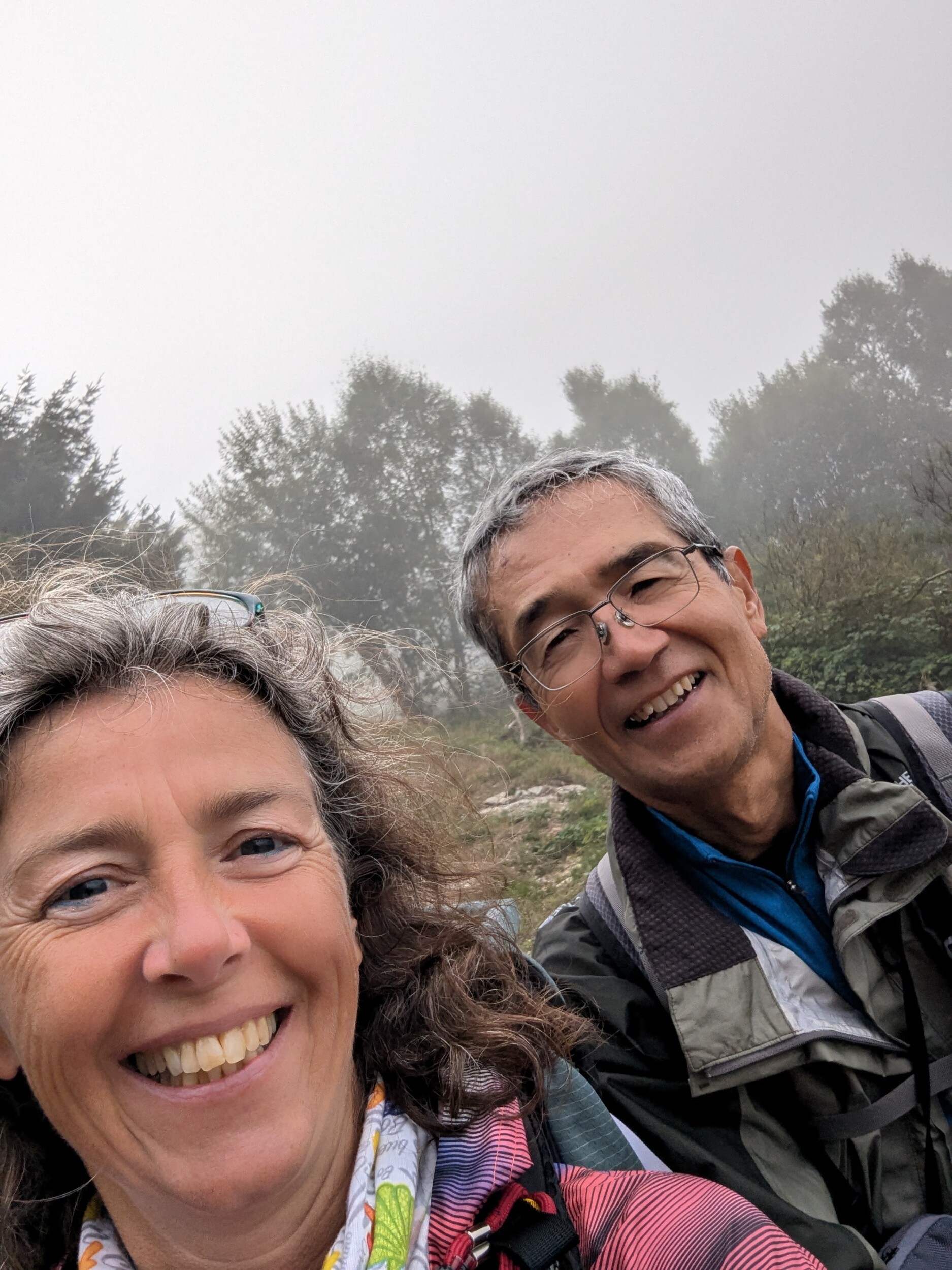
Along the way, at a beautiful viewpoint, you can offer to take a photo of the other person, and ask if that nice photo can also be taken of you.
If you’re more practical, you can offer help to a fellow pilgrim. With cooking / or hanging up laundry, etc.
For example, the church hostel in La Faba has a free old-fashioned spin dryer, but you need to know how to use it. I helped several pilgrims with it, and their gratitude was priceless. It was a chilly day, and otherwise their clothes would never have dried.
You Can Also Share Practical Tips with Your Fellow Pilgrims
If you think you see something the other person might not understand or isn’t doing right, give your advice. Who knows, it might help someone enormously by adopting a better posture. Holding the poles differently or having the backpack sit better on the back.
If you find this difficult, you can also work on your timing. For example, be the first at the table / in the kitchen at dinner. Pilgrims then come in and you have all the time to calmly start a conversation.
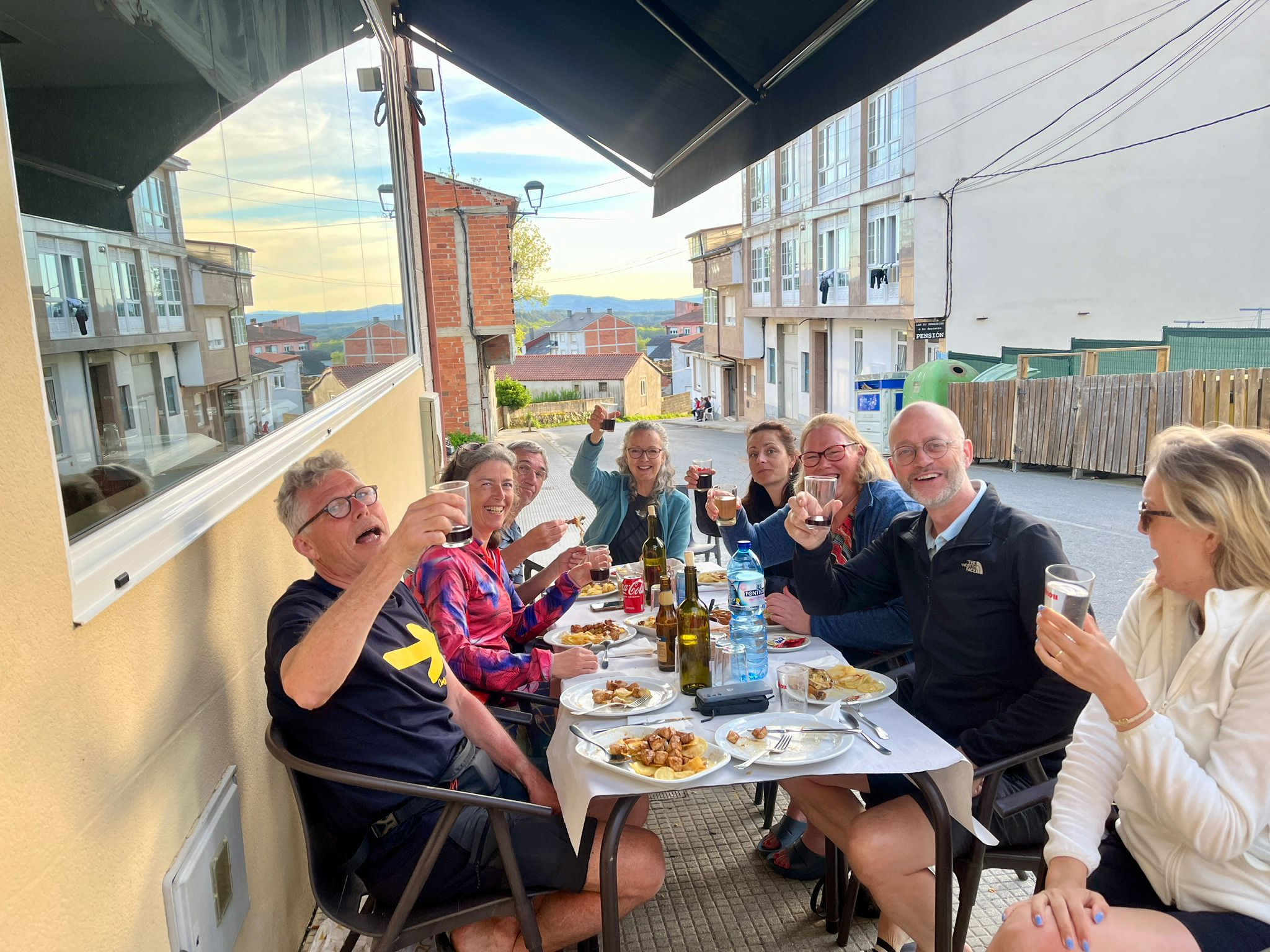
Non-verbal Signals (Smiling, Eye Contact)
Non-verbal signals are an easy way to break the ice. Make someone feel seen by smiling. This makes someone feel more welcome and also inclined to smile back and say hello.
Read what a smile does to you and to others
Also make real eye contact and try not to constantly communicate with the home front on your phone. That’s important too, but it shouldn’t hinder your experience in the moment on the Camino.
3. Embracing Cultural Differences
On the Camino you meet the whole world. Different rhythms, habits around eating and rest, ways of communicating. Be genuinely curious. If someone cooks something you don’t know, ask about it. You learn so much from each other’s habits.
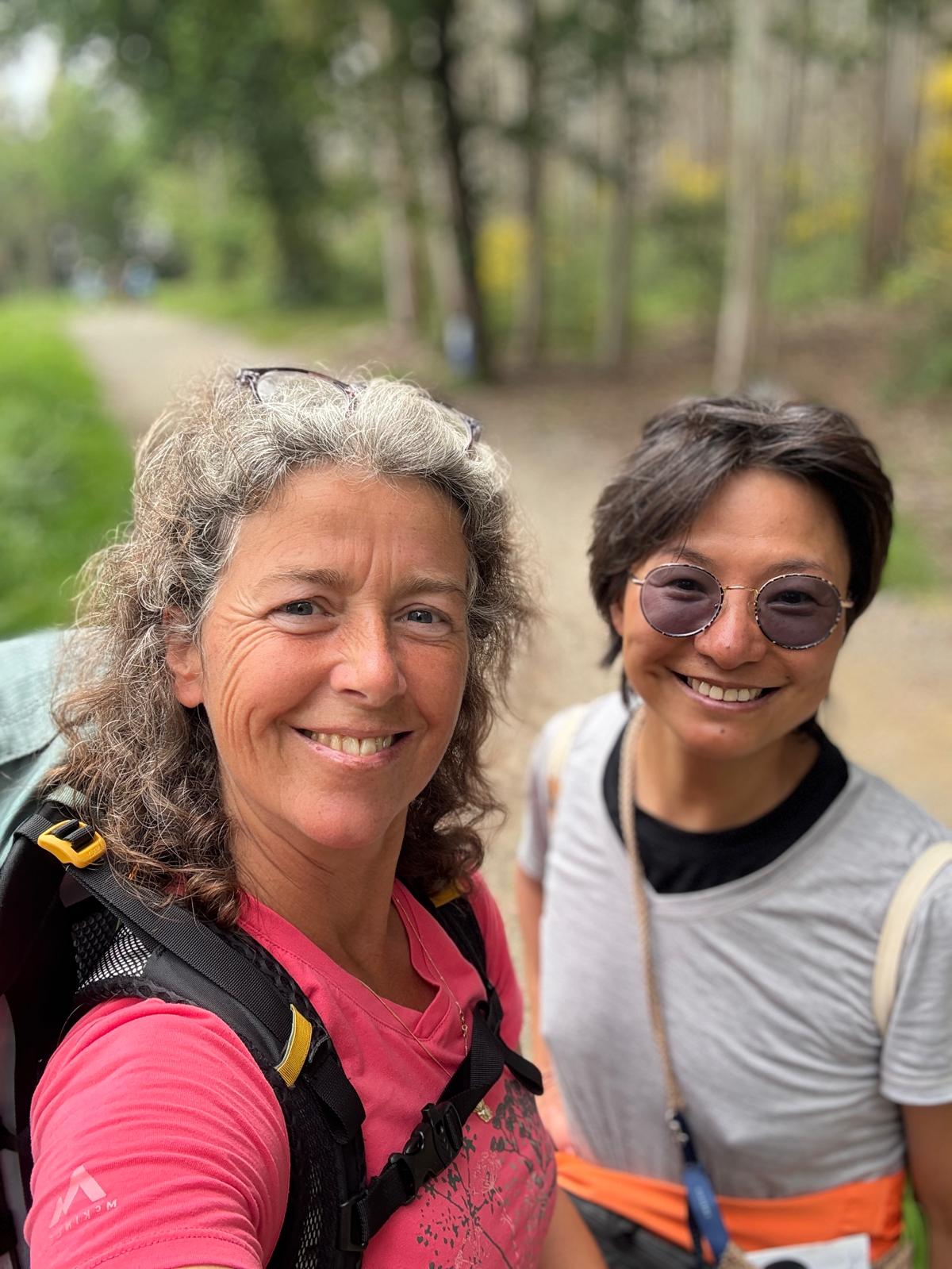
Language barriers? Everyone speaks “Buen Camino.” Hands and feet do the rest, laughing about miscommunication works wonders. And it’s precisely that shared vulnerability that opens hearts. Curiosity quickly wins over judgment.
Share your own culture, explain why you do things your way. That Dutch directness? Explain that it’s well-meant, not rude. This creates real connections beyond cultural differences. Those differences make the world and the Camino so rich – cherish them!
Also read why stamps are collected in a passport on the Camino de Santiago
Looking to walk a camino? But not alone? Join me on the last 200 km to Santiago de Compostela
Overcoming social anxiety on the Camino
4. For the Introverted Pilgrim
Are you more of a listener than a talker? Making friends on the Camino de Santiago then seems harder. Plan your social moments more consciously. The communal kitchen, for example. In the evening it offers a perfect basis for a nice conversation. Whether you cook yourself or join someone, conversation often flows naturally when you’re cooking.
Your pace, your comfort. Start small and familiar, seek contact with 1 person. Maybe you join a pilgrim walking alone and cheerfully say: “Buen Camino” and ask how his/her body feels today.
Listening is perhaps your superpower. Pilgrims have stories to tell and you’re the perfect listener. Ask a simple question: Why are you walking the Camino? This creates deeper connections than superficial small talk.
Take the rest from social moments when you need it. It’s completely okay to walk alone and go to bed early. Pilgrims understand that everyone has their own rhythm.
5. Albergue Etiquette – The Unwritten Rules
In the albergue you share spaces with fellow pilgrims. Taking each other into account is how a warm community and friendships arise. Do you snore? Share it honestly and offer earplugs – humor always helps!

Become a silent hero! Pack everything the evening before and be as quiet as possible. Your fellow pilgrims are still dreaming of Santiago de Compostela 🙂
Create space for everyone and keep your things close to your own bed. Hanging up your laundry can also be a nice puzzle, help each other find spots.
The kitchen is also a space by and for everyone. Sometimes others are a bit chaotic – clean up with a smile and another might follow your example. The question: “Who wants my last pasta?” opens hearts and fills stomachs.
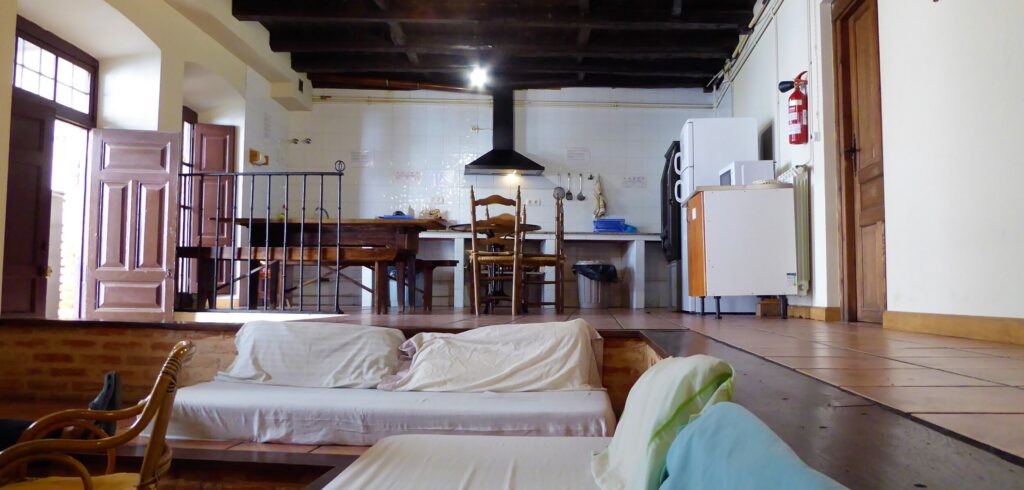
Also read my blog What’s the Budget for the Camino
6. From Albergue Friends to Lifelong Bonds
I want to take you to that last evening in Santiago, when I realized I had to say goodbye to people who had become incredibly dear in just a few weeks. You want to maintain those friendships. But how do you do that?
Send a personal message with a specific memory. “Every time I put on my walking shoes I see you treating my blisters there in Astorga!” That touches, because it was real.
What makes these friendships, with your Camino family, so different? You got to know each other without masks. Tired, sweaty, sometimes frustrated, but also beaming with small victories. They carried you mentally when you couldn’t see it anymore, encouraged you when Santiago still seemed unreachable.
This creates a bond that goes deeper than ordinary friendships. You share a secret that only pilgrims understand: the magic of being on the road, of letting go, of trusting. And you don’t forget that, even when everyday life engulfs you again.
7. Just Take the Step – Walk a Camino
Encouraging people to take that step too. Sometimes you think year after year, I would like to as well. It seems like something for me. Could I do it? Is it for me?
You can only answer all those questions by actually taking that step. The first step towards walking a Camino and ultimately making friends on the Camino de Santiago.
Remember my transition. Earlier I stood a bit outside the social world, in terms of feeling you know? During my 35 days of walking, I really felt like I belonged, that I could also be of value and vice versa.
Have you also made beautiful albergue friendships? Share them with me in the comments, I’m very curious!
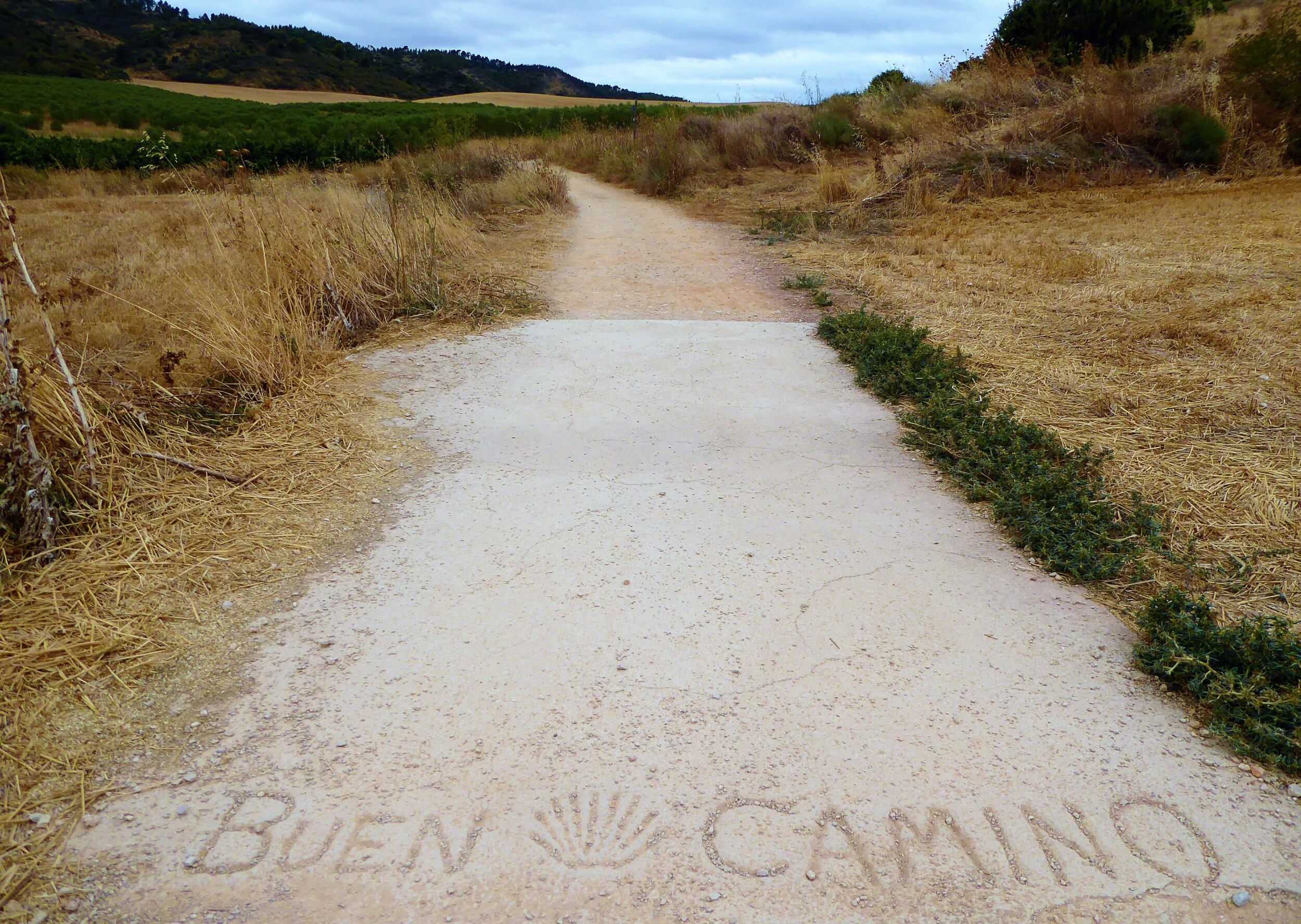
Read More About the Camino:
- ravel Guide for Accommodation on the Camino de Santiago
- Budget for your Camino: What does a pilgrimage cost?
- Hiking a Pilgrimage – pros and cons for summer and winter
- Read the Camino packing list
Would you rather not take the first pilgrim step alone?

